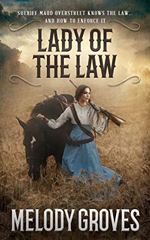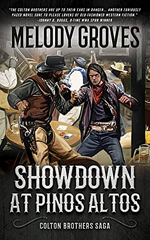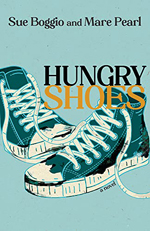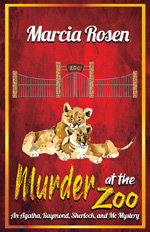Melody Groves is the author of nine historical western novels across two series, five nonfiction books about the West, and numerous magazine articles. Her two newest releases, Lady of the Law (Maud Overstreet Novel #2) and Showdown at Pinos Altos (The Colton Brothers Saga #7), were both published in 2023 by Wolfpack Publishing. You’ll find Melody on MelodyGroves.net and her Amazon author page. Read more about Melody’s writing in her 2016, 2018, 2021, and 2022 interviews for SouthWest Writers.
 Melody, 2023 was quite a year for you. You published two books in 2023 and won the Spur Award for the biography Before Billy the Kid: The Boy Behind the Legendary Outlaw. And in April, you took the leap from Vice President of the Western Writers of America (WWA) to President of the organization. Before we get into your latest publications, can you please tell us about your journey with WWA and what that means to you?
Melody, 2023 was quite a year for you. You published two books in 2023 and won the Spur Award for the biography Before Billy the Kid: The Boy Behind the Legendary Outlaw. And in April, you took the leap from Vice President of the Western Writers of America (WWA) to President of the organization. Before we get into your latest publications, can you please tell us about your journey with WWA and what that means to you?
Also in 2023, Trail to Tin Town was in the hands of a new publisher (Wolfpack) who released the eBook and paperback versions of the book. And I won the Will Rogers Gold Medallion for an article in Wild West Magazine about Billy the Kid’s mom. It was quite the year!
The journey to where I am now was a crazy and circuitous one. I joined SWW about a million years ago and attended every meeting, took many classes, met publishers and accomplished writers. At one SWW meeting, I met Tony Hillerman and his friend, Luther Wilson, who was the head of UNM Press. Wilson published my first book All About Rodeo—because I got the chance to talk to him, while Hillerman was swarmed!
Then, two SWW members gave me a mighty nudge to join Western Writers. By that time, I’d had several articles published, plus the rodeo book, so it turned out I was eligible! I joined and am so glad I did. Just like in SWW, I went to all the annual conventions, read WWA’s magazine Roundup, asked a ton of questions and eventually was published again because of being face-to-face with publishers and editors at the conventions.
WWA members are of a like mind — all love Westerns and want to be multi-published. We want to keep the genre alive. When asked to run as Vice President, I was terrified and honored. There are over 700 international members, and I knew someday I would be president. It was a six-year commitment — two as vice president, two as president, two as past president — but I agreed to take it on.
After nine months as VP, I was thrown into the presidency after the president quit. The WWA board and members couldn’t have been more supportive. Everyone jumped into action, and I think the organization is stronger because of the initial chaos. It took a while for me to think straight, but with a new executive director (he and I work together well), I’ve been able to address some issues. I’m ready to move forward with this new year.
For those who are new to you and your work, can you give readers some background regarding your writing career and what that path has looked like?
I wish I could say I planned out my career and moved forward with purpose. Instead, I simply knew I wanted to write, and my favorite genre was Westerns (probably from growing up in southern New Mexico). I was the newspaper editor in junior high, on the staff in high school, and a journalism minor at NMSU (Go Aggies!). Writing was a natural fit. I took time away from writing to raise children and to teach in Albuquerque Public Schools. In addition to teaching Gifted (I have an MA from UNM), I taught 6th grade language arts/literature. I had students write during the first 15 minutes of class. So…to model appropriate behavior, I did, too. Sometimes, that 15 minutes grew to 20. My first novel was written in class. I left teaching over 20 years ago to write novels and nonfiction books, and now have 15 — soon to be 18 in June — with my name on them. I’ve written tons of magazine articles as well.
Lady of the Law is the second book of the Maud Overstreet Series. What was the inspiration for this series, and do you see it taking on the same lifespan as the Colton Brothers Saga?
I have no idea what the inspiration for this series was. It was another case of a character sitting on my shoulder, talking to me constantly, wanting her story told. She wouldn’t shut up, so I wrote the first book, She Was Sheriff. I did the sequel, Lady, because publishers like more than a one-hit-wonder, and because the story wasn’t done in the first book. I don’t see it running much past book three — which I haven’t started on yet. It’s in the queue, though.
Does Maud, in Lady of the Law, embody any of your real-life traits?
Funny you should ask. Yes, there’s a lot of me in her. I didn’t plan for it, but when the subconscious takes control, the writing flows naturally. I hope Maud comes across as honest and likeable (ahem).
 Showdown at Pinos Altos is the seventh novel in the Colton Brothers Saga. Please tell us a little about this latest book.
Showdown at Pinos Altos is the seventh novel in the Colton Brothers Saga. Please tell us a little about this latest book.
I didn’t mean for it to be part of the series, but here it is. This is a book I’d written several years ago, put in a top drawer, pulled it out last year, submitted it for publication, and wham, there it is in print. It features the youngest of the four brothers and is set in the Black Range in New Mexico. I enjoyed writing it because I used to go up into that area when I was a child, camping with my parents.
I had read that during your years with the New Mexico Gunfighters Association that you “loved being the ‘bad’ guy.” Which comes easier for you when writing: good guys or bad guys?
Bad guys I find easier to write. I think it’s the writer’s inner demon coming out. The problem with bad guys is each needs a good trait—one thing to make them loveable, or at least identifiable to readers. It’s easy to go overboard making the villains really bad, so I find I have to scale back on making them especially gritty.
It’s important to give characters little quirks. Is this something that should be applied to both minor and major characters within a novel, or can it be overdone?
Quirks. I’d say yes to any character—except how minor is a minor character? If he/she is a “walk on,” then I don’t worry about quirks. But if they’ve got more than a couple of lines and somehow affect the storyline or main character, then yes, make them more “rounded” by adding quirks.
Your novels take place in several states. How do your settings impact the stories and the characters?
A setting in a Western is considered one of the characters. That is something that identifies the genre. Consider deserts—a cowboy rides through cactus and sand dunes—he’s got to survive which is a story by itself. Settings are crucial in Westerns, not so much in say, a bodice-ripper.
When researching for a book, do you travel to the location you’re writing about, or are you able to intuit much of what you need to make each story come alive?
Almost always I travel to the location, or I’ve already been there. You learn so much by exploring the area. For example, in Lawrence, Kansas, researching Kansas Bleeds, I would have gotten it all wrong if I hadn’t traveled there, talked to tourist information people, etc. The topography has changed since the Civil War. It’s important to get flora and fauna correct and you can’t do that well sitting at home with Wikipedia. If writers can’t travel there, I’d send for brochures or call the appropriate agencies. They’re happy to put writers on the correct track (been there, done that).
Now that you have several novels under your “cowgirl belt” or should I say “hat,” what marketing techniques have served you best?
Marketing is tough, especially in a niche market. I find standing there selling works best. I go to several Western events each year and my books sell well there. I attend the Tucson Book Festival and sell at the Sandia High School Arts & Crafts Fairs. I do surprisingly well there, too. I’m not sure if buying ad space in magazines is fruitful. The best technique is television. Radio, I believe, is second. If you can get an interview on tv, that’s money in the bank. I’ve done tons of radio interviews and I’m not sure if it generated more sales or not. It was fun, though, and that’s what life is all about.
 I’m curious as to how much of a role you play in your book cover designs? How did you feel when you saw your first book cover come to life?
I’m curious as to how much of a role you play in your book cover designs? How did you feel when you saw your first book cover come to life?
Ah, covers! I try to influence the design, but I don’t always get a choice. I’ve been fortunate for several of my books to even design the cover, but some publishers (I’ve had 7) want to do it themselves. As for my first book cover, frankly, I was disappointed. It was my rodeo book and I thought too dark. They wouldn’t use the photo I wanted because you could see the bull rider’s face and I didn’t have a signed release from the rider. But the book has sold well despite my chagrin. (Cover tip — ask for orange somewhere. Studies show covers with orange sell best. Who knew?)
Can you give us a hint as to what writing projects are forthcoming?
In June, look for my three books in a new series tentatively titled Nolan Brothers Ride Again, about three brothers in 1871 Texas who have their trials and tribulations. Each book features one of the brothers. This was a three-book deal with the publisher, the first two are done and submitted. The third book is due end of April, and they’re telling me the books will be published in June. Keep fingers crossed. I’m excited about this project as I’ve never written a story set in Texas.
How can readers discover your work?
My work is all over the internet. Actually, I am. I have a new website that makes it easy to purchase my books. Unfortunately, a couple titles are hard to find through Amazon as the publisher went out of business. I’m in the process of finding a new publisher for those. Some of my books are in libraries, which is exciting, and local bookstores.
Is there anything else you’d like readers to know?
I’d like to give some advice — if you want to be a successful author (your definition), you’ve got to talk to writers and publishers face to face. Go to conventions, meetings, conferences, on-line events. I know putting yourself out there is scary and tough, but that’s where you’ll find success — meeting people. It’s money and time well spent.
Thank you for reading this. I’m always happy to help. Questions? Send me an email to melodygroves@comcast.net.
 Su Lierz writes dark fiction, short story fiction, and personal essays. Her short story “Twelve Days in April,” written under the pen name Laney Payne, appeared in the 2018 SouthWest Writers Sage Anthology. Su was a finalist in the 2017 and 2018 Albuquerque Museum Authors Festival Writing Contest. She lives in Corrales, New Mexico, with her husband Dennis.
Su Lierz writes dark fiction, short story fiction, and personal essays. Her short story “Twelve Days in April,” written under the pen name Laney Payne, appeared in the 2018 SouthWest Writers Sage Anthology. Su was a finalist in the 2017 and 2018 Albuquerque Museum Authors Festival Writing Contest. She lives in Corrales, New Mexico, with her husband Dennis.
 Tell us a little about yourself.
Tell us a little about yourself. Su Lierz writes dark fiction, short story fiction, and personal essays. Her short story “Twelve Days in April,” written under the pen name Laney Payne, appeared in the 2018 SouthWest Writers Sage Anthology. Su was a finalist in the 2017 and 2018 Albuquerque Museum Authors Festival Writing Contest. She lives in Corrales, New Mexico, with her husband Dennis.
Su Lierz writes dark fiction, short story fiction, and personal essays. Her short story “Twelve Days in April,” written under the pen name Laney Payne, appeared in the 2018 SouthWest Writers Sage Anthology. Su was a finalist in the 2017 and 2018 Albuquerque Museum Authors Festival Writing Contest. She lives in Corrales, New Mexico, with her husband Dennis.

 KL Wagoner (writing as Cate Macabe) is the author of This New Mountain: a memoir of AJ Jackson, private investigator, repossessor, and grandmother. Kat has a speculative fiction blog at
KL Wagoner (writing as Cate Macabe) is the author of This New Mountain: a memoir of AJ Jackson, private investigator, repossessor, and grandmother. Kat has a speculative fiction blog at 














